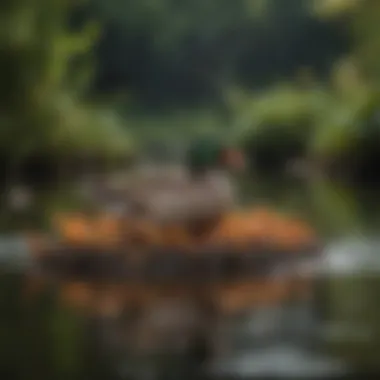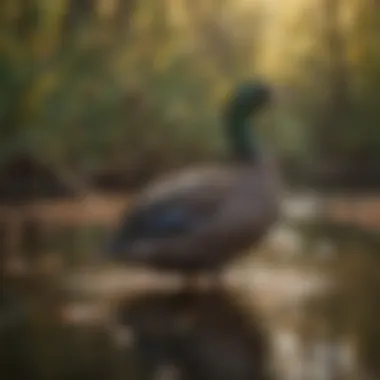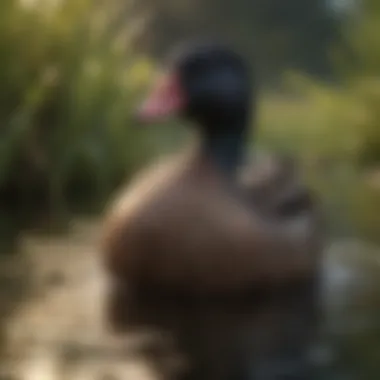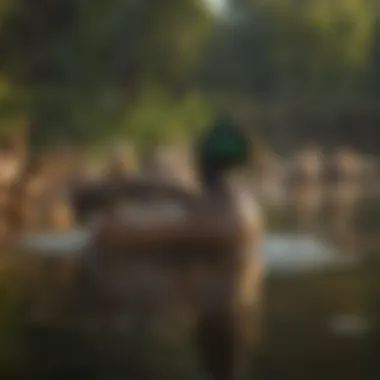Exploring Floating Waterfowl Food: Nutritional Insights


Intro
Floating waterfowl food plays a crucial role in maintaining the health and well-being of aquatic birds. Whether in a natural habitat or a controlled environment, understanding the composition and nutritional value of floating food sources can greatly enhance the care provided by pet owners. This examination will delve into the various types of floating food, the ecological impact of their use, and the specific dietary needs of different waterfowl species. By grasping these concepts, enthusiasts can make informed choices that support optimal health for their birds.
Importance of Floating Food
Floating food serves as a primary source of sustenance for numerous waterfowl species. Birds such as ducks, geese, and swans depend on these readily accessible nutrients. The utilization of floating food can attract a variety of aquatic birds to certain areas, making it a pivotal part of both hobbyist and wildlife conservation practices.
In natural settings, floating plants and seeds are vital for supporting diverse ecosystems. Similarly, in managed environments, providing appropriate floating food ensures the well-being of these birds in captivity or during rehabilitation. An understanding of floating waterfowl food can thus facilitate a more enriching experience for both birds and their caretakers.
Composition of Floating Waterfowl Food
The various types of floating waterfowl food can include commercial pellets, grains, and natural water plants. Each of these options offers distinct nutritional benefits:
- Commercial Pellets: These are specially formulated to meet the dietary requirements of waterfowl. They typically include protein-rich ingredients such as soybean meal and fish meal, along with vitamins and minerals necessary for health.
- Grains: Corn, millet, and wheat can be beneficial, providing essential carbohydrates. However, they should complement other food sources rather than serve as the sole diet.
- Natural Water Plants: Plants like duckweed and water lilies are nutritious and help maintain the natural feeding behavior of waterfowl. They also create a more ecologically balanced environment.
When selecting floating food, pet owners must consider the specific needs of their birds, as nutritional requirements can vary between species.
Ecological Implications
Utilizing floating waterfowl food can have ecological consequences, both positive and negative. On the one hand, supplemental feeding can support populations of desired species, particularly in restricted habitats or during harsh weather conditions. On the other hand, excessive feeding can lead to nutrient pollution in water bodies, resulting in algal blooms that can harm aquatic ecosystems.
Thus, it is critical for bird keepers to strike a balance, ensuring they adhere to guidelines that prevent overfeeding while still meeting the nutritional needs of their birds.
Understanding the importance of floating food can help pet owners create a healthier environment for their aquatic birds, benefiting both the birds and the ecosystem they inhabit.
Finale
In summary, floating waterfowl food is indispensable for the health and vitality of aquatic birds. Knowledge of its types, composition, and ecological impact provides a robust framework for both hobbyists and those involved in conservation efforts. This insight allows for better-informed decisions that can significantly enhance the quality of care extended to these birds.
Preamble to Floating Waterfowl Food
Floating waterfowl food plays a crucial role in supporting various aquatic species. Understanding its definition and purpose helps owners provide better diets for their feathered companions. Proper knowledge of floating food sources supports overall health and well-being of waterfowl in different ecosystems.
Definition and Purpose
Floating waterfowl food refers to any dietary substance that floats on the surface of water bodies, primarily designed for aquatic birds. This type of food includes both natural and commercial options, which provide essential nutrients necessary for the growth, reproduction, and maintenance of various waterfowl species.
The primary purpose of floating waterfowl food is to replicate natural feeding habits, ensuring birds can obtain necessary nutrition without struggling. It meets the dietary needs of species such as ducks, swans, and geese, allowing them to feed effectively. This enhances the birds' health and vitality, contributing to a balanced ecosystem, as healthy waterfowl can positively influence their environment.
Significance in Aquatic Ecosystems
The significance of floating waterfowl food extends beyond individual bird health. It contributes to the overall stability of aquatic ecosystems. Floating food sources help sustain various species, which in turn aids in maintaining biodiversity.
Waterfowl play a role in regulating plant growth within their habitats. They consume excessive plant biomass, promoting a healthier balance among aquatic vegetation. This natural consumption also facilitates the nutrient cycle, where nutrients released back into the water support other organisms, such as fish and invertebrates.
Floating waterfowl food not only supports birds but enriches entire ecosystems, creating interdependent relationships among species.
Types of Floating Waterfowl Food
The category of floating waterfowl food is central to understanding the dietary options for these aquatic birds. It is essential to explore both natural sources and commercial food products, as each type plays a distinct role in maintaining the health and well-being of waterfowl. By recognizing the different characteristics and implications of these food types, pet owners and enthusiasts can make informed decisions that promote optimal nutrition for their birds.
Natural Sources


Submerged Vegetation
Submerged vegetation presents a vital food source for many waterfowl species. This type of vegetation consists of aquatic plants that grow underwater, providing both nutrients and habitat. Key characteristics of submerged vegetation include its ability to reduce water temperature and enhance oxygen levels in water bodies.
Its contribution to healthy ecosystems cannot be overstated. These plants offer a diverse array of nutrients; they can be a rich source of carbohydrates and fibers necessary for digestion. Additionally, submerged vegetation plays an essential role in stabilizing sediment and preventing erosion.
However, while submerged vegetation is beneficial, it also has its unique features and challenges. The growth patterns can vary with seasons and water quality, which may lead to limited availability at times. Therefore, it is crucial for waterfowl to have access to various food sources, as a reliance solely on submerged vegetation could lead to nutritional deficiencies during sparse growth periods.
Algae and Phytoplankton
Algae and phytoplankton represent another natural source of floating waterfowl food. These microscopic organisms thrive in water and are crucial in nutrient cycling. They are notable for their high protein content and essential fatty acids that waterfowl require.
One key characteristic of algae and phytoplankton is their rapid growth in nutrient-rich conditions, allowing them to proliferate quickly. This characteristic makes them a popular food source, especially in areas where other food may be limited. They provide immediate nourishment and attract various waterfowl species looking for adequate sustenance.
However, the consumption of algae and phytoplankton is not without its disadvantages. Excessive growth, known as algal blooms, can deplete oxygen levels in the water and can lead to harmful toxins. Therefore, while they are a beneficial food source when present in moderation, their overabundance can have unintended ecological consequences.
Commercial Food Products
Pellets and Crumbles
Pellets and crumbles are among the most common commercial food products for waterfowl. They are specifically formulated to meet the nutritional needs of various waterfowl species. The primary advantage of pellets is their convenience. They are easy to store and offer a balanced blend of nutrients. They typically contain proteins, fats, vitamins, and minerals that promote overall health.
The key characteristic that makes pellets a popular choice is their quality control during manufacturing. Many companies ensure that these foods meet specific guidelines, ensuring that bird owners provide their pets with safe and nutritionally complete diets. They also reduce waste, as waterfowl tend to consume most of what is given.
On the downside, reliance solely on pellets can limit the birds' access to the variety of natural foods they might encounter in their habitats. A mixed approach, integrating pellets with natural foraging, could provide the best results in promoting well-being.
Floating Grains
Floating grains, such as corn or wheat, serve another avenue for feeding waterfowl. These grains float on the water's surface, making them accessible for birds that prefer to feed on the top layer of water. They are rich in carbohydrates and offer an immediate energy source for waterfowl, making them a popular choice during migration periods.
A key characteristic of floating grains is their attractiveness; they draw in a wide variety of waterfowl. This quality is particularly beneficial for attracting different species to a feeding location.
However, floating grains may also come with certain disadvantages. They can lead to overfeeding if not monitored, which might impact water quality or local ecosystems. Additionally, floating grains alone do not provide all the necessary nutrients, making it crucial to pair them with other food sources for a balanced diet.
In summary, the understanding of various floating waterfowl food types is indispensable for the health and ecosystem preservation concerning these aquatic birds. By balancing both natural and commercial sources, pet owners can create a comprehensive feeding strategy that enhances the well-being of their waterfowl.
Nutritional Value of Floating Waterfowl Food
Understanding the nutritional value of floating waterfowl food is crucial for the health and well-being of these aquatic birds. Proper nutrition contributes to their overall development, reproductive success, and resistance to diseases. The right balance of nutrients can enhance their physical appearance, energy levels, and longevity. This section delves into specific essential nutrients that waterfowl require, namely proteins, fats, vitamins, and minerals.
Essential Nutrients
Proteins
Proteins are fundamental to the growth and maintenance of tissues in waterfowl. They play a vital role in muscle development and recovery. A key characteristic of proteins is their amino acid composition, which is essential for the synthesis of enzymes and hormones. High-quality protein sources, such as those found in commercial pellets or natural aquatic vegetation, are beneficial for waterfowl. One unique feature of proteins is their ability to maintain feather quality, an important aspect of waterfowl health. However, an excessive intake can lead to disproportionate growth or other metabolic issues.
Fats
Fats serve as a concentrated energy source for waterfowl, which is particularly important during migration periods. A notable characteristic of fats is their energy density, which is higher than that of carbohydrates or proteins. This aspect makes fat an essential component of a balanced diet. Fats derived from fish meal or plant oils can provide omega-3 fatty acids, which are supportive of heart health and feather quality. Yet, it’s crucial to balance fat intake, as too much fat can lead to obesity and associated health problems.
Vitamins and Minerals
Vitamins and minerals are critical for various biological functions, including metabolic pathways and structural roles in bones and muscles. These nutrients support immunity and enhance the overall resilience of waterfowl. A key characteristic of vitamins is their role in regulating bodily functions, while minerals contribute to bone health and the correct functioning of muscles and nerves. Diverse sources of vitamins and minerals, such as leafy greens and commercial mixes, are beneficial for a well-rounded diet. However, deficiencies can lead to serious health issues, underscoring the importance of ensuring that waterfowl receive the recommended amounts.


Comparative Analysis with Other Diets
A comparative analysis of floating waterfowl food with other diets highlights distinctive nutritional profiles. Many species of waterfowl thrive on diverse diets consisting of aquatic plants, insects, and small invertebrates. In contrast, controlled diets often rely on formulated feed, which may lack biodiversity. While commercial diets can provide consistency in nutrient delivery, they may not fully replicate the nutritional variety found in natural foraging. Integration of both natural and formulated diets can optimize health outcomes for waterfowl, ensuring they receive a balanced intake of essential nutrients.
Feeding Practices for Waterfowl
Feeding practices for waterfowl are essential for the health and well-being of these birds. Understanding how to effectively manage their feeding can lead to better growth rates, improved reproduction, and enhanced overall health. Different feeding techniques and proper frequency play a significant role in the sustainability and quality of food intake for various waterfowl species.
Feeding Techniques
Surface Feeding
Surface feeding is a common method employed by many waterfowl. This technique involves birds foraging for food that floats on the water's surface. It is particularly popular among species like ducks and geese. One key characteristic of surface feeding is that it allows waterfowl to easily access aquatic plants and small invertebrates without diving. This method is beneficial because it reduces energy expenditure compared to alternative feeding methods.
A unique feature of surface feeding is that it can be conducted while the birds are resting or socializing. This adds an advantage in terms of time management within the group. However, there may be disadvantages, especially when water conditions fluctuate or when there is limited food availability on the surface.
Diving Behavior
Diving behavior is another feeding technique exhibited by various waterfowl species. It involves birds submerging themselves to forage for food beneath the water. This method is crucial during periods when surface food is scarce. The key characteristic of diving behavior is its ability to tap into a broader range of food sources, such as bottom sediment and submerged plants.
Diving is considered beneficial for species that rely heavily on aquatic vegetation and small fish. However, it may require more energy than surface feeding and can be time-consuming, limiting the amount of food gathered in a short period. Moreover, diving can expose birds to increased predation risk, particularly when they are vulnerable during the ascent to the water's surface.
Feeding Frequency and Quantity
The frequency and quantity of feeding are critical aspects to consider. Waterfowl generally exhibit different needs based on their age, species, and environmental conditions. Providing food at regular intervals encourages healthier behavior and minimizes stress among the birds. It is recommended to feed waterfowl multiple small meals throughout the day rather than one large feed. This practice helps ensure that the birds receive a balanced intake of nutritious food.
When determining the quantity, it is essential to consider the size of the flock. Overfeeding can lead to waste, which affects local ecosystems and can potentially lead to pollution. Furthermore, inefficient feeding practices may reduce the birds' natural foraging instincts and overall health. Thus, keeping an eye on their consumption is an important practice for waterfowl care.
When managing feeding practices, it is vital to harmonize the needs of waterfowl with environmental sustainability.
Ecological Impacts of Floating Waterfowl Food
The ecological impacts of floating waterfowl food are significant, affecting both the aquatic environment and the birds themselves. Understanding these impacts is crucial for pet owners and bird enthusiasts who want to ensure their birds thrive in a balanced ecosystem. The influence of floating food sources extends beyond the physical presence of food; it plays a vital role in supporting local wildlife, managing water quality, and maintaining biodiversity.
Impact on Local Ecosystems
Natural and commercial floating waterfowl food contributes directly to the health of local ecosystems. These food sources provide not only nourishment for waterfowl but also create habitats for other aquatic life. For instance, submerged vegetation and algae offer shelter and breeding grounds which increase the biodiversity of a water body. The presence of waterfowl can stimulate growth of these plants as they disperse seeds while feeding.
Additionally, floating waterfowl food influences nutrient cycling within aquatic ecosystems. When birds consume food and excrete it back into the water, they enrich the nutrient content, which can promote the growth of phytoplankton and other essential organisms. However, this process must be balanced. Too much nutrient influx can lead to algal blooms, which pose a risk to fish and other wildlife, disrupting the harmonic structure of the ecosystem.
Waterfowl often act as indicators of ecosystem health. Their behavior and population fluctuations can signal environmental changes. Thus, careful management of floating waterfowl food can alleviate potential negative impacts while enhancing positive ones.
Overfeeding and Its Consequences
Overfeeding waterfowl can lead to various ecological problems. It is primarily driven by the misconception that providing excess food will benefit the birds. Instead, it often creates an imbalance. High concentrations of food can lead to overpopulation in a specific area, which can increase competition among species. This pressure can damage local vegetation, leading to a decrease in habitat quality for not just waterfowl but also for other wildlife.
Overfeeding can disrupt natural foraging behavior, training birds to rely on external food sources rather than seeking out a natural diet.
Moreover, decomposing uneaten food contributes to sedimentation and deteriorates water quality. This change can facilitate the growth of pathogens and harmful bacteria, posing significant risks to both bird health and the water ecosystem.
To prevent these consequences, it's essential for waterfowl care providers to be mindful of their feeding practices. Implementing responsible feeding guidelines helps maintain healthy populations and a stable ecosystem.
Regulations Surrounding Waterfowl Feeding


Feeding waterfowl may seem straightforward, but it comes with a set of regulations aimed at protecting both the birds and their environments. Understanding these regulations is crucial for responsible feeding practices. Such regulations are put in place to ensure the sustainability of waterfowl populations and the health of ecosystems. Ignorance of these laws can lead to adverse effects, not only on the waterfowl but also on local ecosystems. Therefore, compliance with these regulations is essential for anyone who wants to engage in providing food to waterfowl.
Legal Considerations
Laws concerning waterfowl feeding can vary significantly between regions. It is vital for waterfowl enthusiasts to familiarize themselves with the specific legal frameworks applicable in their local areas. For instance, some locations may prohibit feeding certain species or mandate using specific types of food.
- Local Wildlife and Fishery Laws: Many regions have specific laws aimed at protecting local wildlife. Violating these laws may result in fines or other penalties. An example is the prohibition of feeding ducks and geese with bread, as it can harm their health.
- Conservation Areas: Areas that are designated as wildlife refuges often have strict feeding regulations. These areas aim to preserve natural habitats and may restrict feeding to avoid dependency on human-provided food sources.
- Permit Requirements: In some instances, individuals may need permits to feed waterfowl in public spaces. It is important to check for any required permits to avoid potential legal issues.
Best Practices for Compliance
Adhering to regulations is crucial, not just to avoid legal issues, but to ensure responsible animal care. Understanding best practices for waterfowl feeding can help enthusiasts support the health and well-being of these birds while staying in accordance with local regulations.
- Use Species-Appropriate Foods: Always provide food that is suitable for the specific waterfowl species in your area. Using commercial products that are formulated for waterfowl is a good practice.
- Feed in Moderation: Overfeeding can lead to overcrowding in specific areas, resulting in negative environmental impacts. It is prudent to limit the amount of food provided.
- Avoid Processed Foods: As mentioned earlier, bread and other processed foods can be harmful. Stick to natural grains or formulated pellets for optimal health benefits.
- Observe Local Wildlife: Be attentive to local wildlife patterns. If birds are congregating in large numbers, it may be best to reduce feeding to avoid disruptions.
Staying informed about local regulations and following best practices for compliance not only protects the birds but also contributes to the overall health of their habitat.
Innovations in Floating Waterfowl Food
The exploration of innovations in floating waterfowl food reveals significant advancements aimed at enhancing the health and well-being of aquatic birds. This section discusses recent developments that focus on sustainable production and incorporation of technology, both of which are crucial for the future of waterfowl care. With increasing awareness of ecological principles, the emphasis on sustainability becomes vital.
Sustainable Options
Sustainable practices in the production of floating waterfowl food are essential for minimizing environmental impact. This approach often involves the use of renewable resources and eco-friendly materials. One innovative method is the incorporation of aquatic plants that can thrive in natural water bodies. Native plants, such as eelgrass or duckweed, can serve as natural food sources.
Additionally, companies are now optimizing food formulations to ensure they are natural and minimally processed. For example, some brands now use ingredients derived from sustainable agricultural practices, such as organic grains and plant-based proteins. These ingredients not only provide the necessary nutrition for waterfowl but also support an eco-conscious approach.
Some potential benefits of sustainable options include:
- Reduced ecological footprint.
- Improved overall health of waterfowl.
- Better resource management within local ecosystems.
Technology in Feeding Solutions
In the realm of technology, innovations are driving enhancements in feeding solutions for waterfowl. Automated feeding systems, for instance, are making it easier for pet owners and enthusiasts to provide consistent nourishment while ensuring minimal waste. These systems can be programmed to dispense food at specific times, promoting a more structured feeding routine for the birds.
Another significant advancement involves smart feeding platforms that monitor the feeding behavior of waterfowl. These platforms can analyze feeding patterns, adjust portion sizes based on the number of birds, and even provide insights into waterfowl health over time. This technology not only simplifies feeding but also helps ensure a balanced diet.
The integration of mobile applications for tracking feeding schedules and nutrient intake is also gaining traction among waterfowl enthusiasts. With these innovations, pet owners can engage in more meaningful and informed care of their aquatic companions.
With advancing technology, the future of floating waterfowl food looks promising, ensuring better care and sustainability.
The application of technology in feeding solutions, combined with sustainable options, supports a holistic approach to waterfowl management, enhancing both their quality of life and their connection to the environment.
Ending
The conclusion provides not only a summary of the information discussed but also emphasizes the broader implications of understanding floating waterfowl food. It is crucial for pet owners and enthusiasts to grasp the significance of proper nutrition for their aquatic birds. This understanding will enhance both the health and well-being of the waterfowl in their care.
Before delving deeper into the key points, it is essential to acknowledge the importance of floating waterfowl food in maintaining a balanced and sustainable feeding regimen. Providing appropriate food sources will ensure that the birds receive essential nutrients. This contributes to their overall growth and vitality, thereby supporting their natural behaviors and ecological roles.
Summary of Key Points
- Floating waterfowl food plays a critical role in the diet of aquatic birds, offering necessary vitamins and minerals.
- Natural sources include submerged vegetation and various types of algae. These are fundamental for their health.
- Commercial products, such as pellets and floating grains, can supplement their diet effectively when natural sources are scarce.
- Understanding feeding practices helps in promoting healthy eating habits among waterfowl, including frequency and techniques.
- Observing local regulations ensures responsible feeding and prevents ecological imbalances.
Future Directions in Waterfowl Care
Future directions in waterfowl care should prioritize sustainable practices and advancement in feeding solutions. The aim is to cater to the evolving needs of different waterfowl species while considering ecological impacts. Innovations could include:
- Development of organic and environmentally friendly feeding products.
- Implementing smart feeding stations that monitor and regulate food intake.
- Researching and adapting food sources to suit varying climates and habitats, ensuring availability.
- Enhancing public awareness regarding responsible waterfowl feeding practices. This can foster better cooperation within communities supporting local aquatic ecosystems.
Increasing knowledge and practices surrounding floating waterfowl food will ultimately contribute to healthier bird populations and more sustainable ecosystems.







